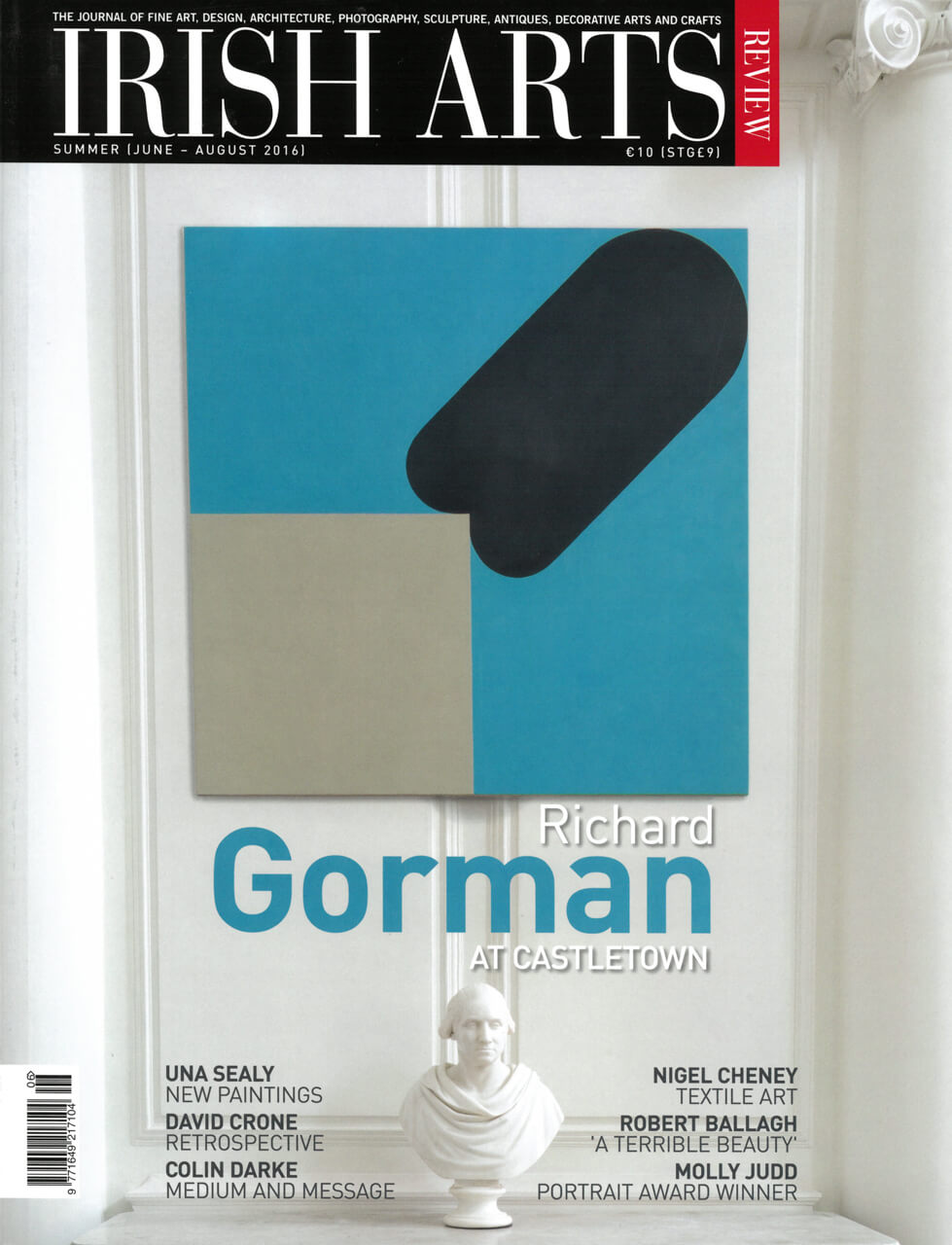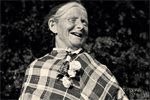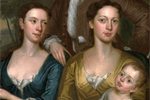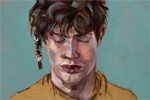
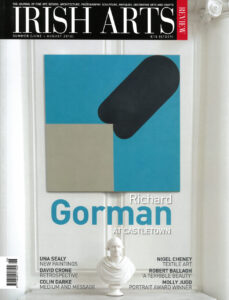
Richard Gorman is marking his 70th year with an exhibition at Castletown, Co Kildare where his colourful abstracts animate the walls of its classical interior, writes Jennifer Goff.
Richard Gorman refers to himself as a painter rather than an artist. Gazing upon his paintings one is struck by the considerations of colour and form, and the expressive qualities and possibilities which these evoke. There is no dogma, no manifesto, no social or political undercurrent in his work, and no underlying narrative. The work does not reflect his personality, his enthralling stories, or his artistic evolution. Instead his work is a celebration of paint, the way it is applied, and the colours and forms which evolve from this process. Recently a subtle change has occurred, in that Richard Gorman’s paintings are breaking free from the confines of canvas and sculpture, into the world of design and architecture, and the results are exhilarating.
Born in Dublin in 1946, Gorman attended D√∫n Laoghaire School of Art, and the school’s Bauhaus principles led to a progressive stance in his formative years. His incredible propensity for graphic work evolved after attending the Atelier Champfleury in the early 1980s. Like many of his contemporaries Gorman appeared on the art scene as the conflict between opposing art philosophies played out in the 1970s to the 1980s. American Abstract Expressionism where the physical approach to art, and the process of art expressed through colour and paint, eventually intertwined with European Abstraction, forming Constructivism, Pop Art, Minimalism, Op Art, and Conceptualism. Gorman’s peripatetic life moving around from Dublin, Milan and Japan also contributed to the stylistic singularity of his work. He is renowned for his reduction of form to a lapidary, geometric idiom, rendered with extreme painterly and technical perfection. For decades he has compellingly demonstrated that the most elementary things are inexplicable.
Gorman’s paintings are like hypnotic vacuums sucking the viewer into the embrace of colour and form. The tectonic and graphic nature of his work combined with myriad perceptual possibilities led to Gorman receiving a commission from the fashion house Herm√®s in 2015. Gorman was discovered by Bali Barret, the artistic director of the Women’s Universe at Herm√®s, through his good friend the French artist and founding member of the Memphis design group, Nathalie du Pasquier (b.1957). Barret was attracted by Gorman’s sense of colour and his sharp abstract work.
Using Castletown in this way also links with Gorman’s understanding and appreciation for the Renaissance and Mannerist movements.
The original Herm√®s Carr√® was designed in 1937, based on a woodblock drawing by Robert Dumas Herm√®s (1898-1978). Throughout the decades the Carr√® has become an iconic fashion object, due to the variety of its designs and for the famous artists such as Raoul Dufy (1877-1953) who have created for the brand. However in the history of Herm√®s it was the first time that an Irish artist was invited to create a design for the label. Until now Gorman, regrettably, has not ventured into the world of design. One can only imagine how wonderful it would be to see a Richard Gorman table, rug, lamp or screen. His printmaking qualities contributed to this collaboration as the company bought one of his paintings. It takes about eighteen months to produce any one scarf design. Engravers take six months to determine each scarf’s distinct colours, which work with skin tones in the face, using colours such as beige, pink, and graphite. Each design is painstakingly silkscreen printed at the Herm√®s workshops in Lyon. Gorman’s result was Squeeze, a series of scarves in seven colourways. Just like his painting Gorman’s design embraced dramatic colour blocks and fluid forms, like turquoise, violet, yellow, cerise, and a burnt sienna orange which combine and contrast with one another. Squeeze also expanded into Herm√®s menswear where the colour choices of bronze, Prussian blue and celadon were made by Véronique Nichanian, artistic director of the Men’s Universe. His involvement with Herm√®s progressed further when in October 2015 he created large-scale works , on specialized Japanese kozo washi paper, as a window display design in the Maison Herm√®s in Shinjuku, Tokyo. Japan has long played an important role in his development as a painter through residencies, exhibitions, an appreciation for the lucidity of Ukioye woodblock prints and the painstaking papermaking which he has completed in the paper factory (an ancestral family tradition) of Iwano Heizoburo.With his exhibition ‘Casa’ at Castletown House Gorman creates a symbiosis between his work and the interior, as if the house was his architectural canvas. The largest and the earliest of the great Irish Palladian houses, Castletown was begun in 1722 by William Conolly (1662-1729) and continued with his great-nephew Thomas Conolly (1738-1803) and his wife Lady Louisa Lennox (1743-1821). The three-storey central block, designed by the Italian architect Alessandro Galilei (1691-1737), is reminiscent of an Italian Renaissance town palazzo. This is joined by curved Ionic colonnades to two-storey seven-bay wings, designed by Sir Edward Lovett Pearce (1699-1733), who supervised the work in the latter stages. Pearce also designed the impressive 2 storey entrance hall where the gallery is supported by Ionic columns. Though an unusual backdrop for such an abstract artist Gorman’s links with Castletown house hark back to early in his career when he and two friends, Robert Maharry and Ruary O Siochain, serendipitously, discovered an important archive relating to the house. This invaluable archive of 165 documents is currently being documented and researched by the Office of Public Works. It pertains to Castletown, its environs and history dating back to 1578. It examines the Conolly family, the articles of agreement for Thomas Dongan’s (1634-1715) sale of Castletown to William Conolly in September 1709, and numerous versions of wills and codicils of the Conolly family notably William and Thomas. Quite randomly, there also was a copy of the will of Phillip, 2nd Marquess of Wharton, later 1st Duke of Wharton, who was reputed to have founded the Hellfire Club and was the son of the notoriously profligate Thomas, 1st Marquess of Wharton, who was Viceroy of Ireland in 1708-10.
Decades after discovering this find, Gorman began to look at using Castletown as the backdrop for an exhibition. Then, in 2015, the theatre of Castletown provided the perfect milieu for the Herm√®s fashion shoot and Gorman’s visualization became a reality. Using Castletown in this way also links with Gorman’s understanding and appreciation for the Renaissance and Mannerist movements. For years Giovanni Bellini (1430-1516), Andrea Mantegna (1431-1506) and Piero della Francesca (1415-20-1492), have informed his work. Struck by their clear, calm arrangement of masses, and the careful tensions in their work, he understood that the way in which these masters applied the paint made their paintings important, rather than just relying on the subject matter. For ‘Casa’ Gorman has revisited works from his past, reworking and repainting them. This exhibition is comparable to taking a journey, not just through Gorman’s painterly development by revisiting the past, but through the house itself. The walls are punctuated with his work, where colours and shapes explode outwards from their canvas, pushing out from the crisp, clean walls of this Palladian house. Each room in the exhibition displays something different; some paintings are prodigiously large, yet hang discreetly on the wall. With other paintings, their patterns, colours, and even the shape of their canvas change and each one reveals a different part of this journey.
Vaulted to double height, Castletown’s entrance hall is an introduction of great grandeur. Here hang two monumental paintings by Gorman, Blunt Flyer (Fig 1) and Node Flyer, which dramatically face each other. There is a haptic quality to these two paintings as the two dimensions of the canvas are surrounded by a border which visually pushes them out from the wall. They combine and contrast with the Ionic columns and the richness of the fine pilasters decorated with classical symbols of wealth. Despite its rich ornamentation, the whiteness gives the entrance a minimalist feeling which is wonderfully offset by Gorman’s bold canvases. There is also an unintentional gradual transition in these paintings. The square (Fig 5) forms in the left hand corner in Blunt Flyer and Node Flyer echo not just one another but also the chequered limestone floor. In one painting the square barely touches one form, whereas in the other it slowly pierces its way through. One questions if these are gendered forms – the squares and rectangular shapes representing the masculine and the ovoid and circular shapes representing the feminine. These colourful paintings confront the viewer, surround them, and, mentally and meditatively draw them into the journey through Castletown and Gorman’s work.
Beyond the hall there is the stunning Portland stone staircase, with its fine brass balustrades, and intricate Rococo plasterwork by Paolo (1695-1776) and Filippo Lafranchini (1702-1779). Tom and Louisa Conolly are represented in this plasterwork. In the Thomas Conolly room, on the first floor, which faces the garden front, hangs Snug One (Fig 6). This painting faces a portrait of Conolly himself, as if the past is looking at the present. Gorman’s palette of blues, yellow, black and grey in this painting compliments the colours in the room. The diaphanous flux of his modulated forms and colour gradation, are rich in nuances and values, creating a space not only within the painting itself but within the room. In Lady Louisa’s bedroom another large-scale painting, Shuffle, hangs on a backdrop of plain brick wall (Fig 4). With this painting his palette is lighter, the colour more luminous, possibly reflecting back to his time in Milan. The salient theme of the interactions of colour is made visible with great sensitivity demonstrating how Gorman is a major colourist. The soft curvaceous, feminine forms reflect the original user of the room. Klik Kan Green, in Lady Kildare’s bedroom (Fig 3), is a new departure in form in comparison to the other paintings. Here colour, space, light and especially motion are called into question – the central form, painted vivid green creates a visual vortex, drawing the viewer not only into the painting but into the architectural environs.
A long curved corridor leading from the central body of the house to the servant’s quarters and the kitchens contains the most intriguing body of work from this exhibition (Figs 7&8). Since the late 1990s Richard Gorman has playfully explored the use of unusual shaped canvases. Taking previous oval paintings which he had completed a number of years ago, Gorman found himself revisiting the works. The oval canvases retain the impression that the forms extend beyond the picture frame. This visual quality is heightened by the corridor’s curved wall and by the uniform size of each canvas. There is also an ethereal quality to Nu Blu, Node Blu, Zeez, Cob, Zag, Kin-oh, Raaw, and Ona, which has evolved from repainting some of the forms and colours (Figs 7&8). This added a translucency to the surface of the paint, which once again echoes the Renaissance masters. Pentimento – is the alteration in a painting, evidenced by traces of previous work. Gorman guilefully has covered nearly all of the earlier elements, some with astonishing results, reflecting a change of mind, or thought, but also an evolution in his work. One questions in years to come if this pentimenti will reappear like ghosts through time on the canvas. ‘Casa’ represents everything which encapsulates Richard Gorman to this very point in time – the subtle changes in his exact, geometric idiom based on colour, form and paint reflects not only an intellectual but an aesthetic discipline. The richness in his work breaking free from the confines of the canvas, and the playful addressing of work from times past, has created a visual language which is firmly rooted in the present.
Richard Gorman ‘Casa’ Castletown, Co Kildare until 30 September 2016.
Photography of Castletown House by Mark Reddy.
Jennifer Goff is Curator of the Eileen Gray Collection, Decorative Arts & History Division at the National Museum of Ireland.
